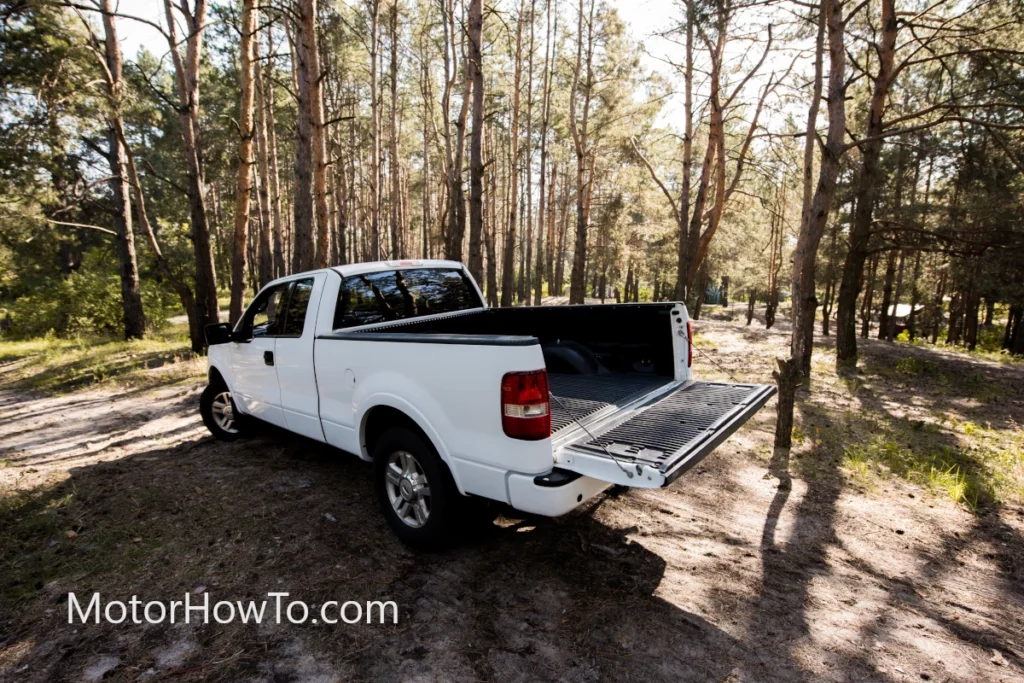In the world of do-it-yourself projects and independent freight handling, the blend of convenience and efficiency is an art.
It’s a world where the essence of rugged utility vehicles, such as pickup trucks, collides with the ubiquitous presence of hefty, square-formed pallets.
This brings to life a particularly intriguing query: how do these elements of the modern DIY and transport scene interact?
A standard pallet typically fits into a full-size pickup truck. However, it’s essential to consider your truck’s load capacity, dimensions, and pallet size. Overloading or improper fitting may risk damage to the vehicle or the items on the pallet. Always prioritize safety.
- Understanding Pallet Dimensions: Standard vs Non-standard Sizes
- Knowing Your Pickup Truck: Load Capacity and Bed Dimensions
- Preliminary Preparations: Ensuring Safe and Secure Loading
- Step-by-Step Guide to Loading a Pallet into a Pickup Truck
- Mitigating Risk: Tips for Safe Transportation of Pallets
- What to Do When Your Pallet Doesn't Fit: Alternative Solutions
- Long Distance Travel: Things to Consider When Transporting Pallets
- Final Thoughts
- Sources

Delving into this puzzle, we embark on an exploration that probes the confines of space, weight, and design, bridging the gap between what we assume and what transpires when we endeavor to marry these two stalwarts of practicality.
Related:
- Is a Pickup Truck Considered an Automobile? A Deep Dive into Vehicle Categories and Nomenclature
- Why Do People Call SUVs Trucks? Unraveling the Semantic Mysteries of Automotive Terminology
- Silverado C1500 vs. K1500: Which Pickup Truck Should You Choose?
Understanding Pallet Dimensions: Standard vs Non-standard Sizes
The first step in determining if a pallet will fit into a pickup truck involves understanding pallet dimensions. Pallet sizes can vary significantly, but North America’s most commonly used pallet is the standard GMA (Grocery Manufacturers Association) pallet, which measures 48 inches by 40 inches.
This size is widely used in various industries because it can carry considerable weight and is easily moved with standard pallet jacks and forklifts.
However, not all pallets adhere to these standard dimensions. Non-standard sizes are used for specific applications or in certain regions.
These can range from 36 inches by 36 inches to 48 inches by 48 inches or even larger. Thus, measuring the pallet you’re working with is crucial before loading it into your pickup truck.
| Pallet Type | Dimensions (inches) |
|---|---|
| Standard GMA | 48 x 40 |
| Euro Pallet | 47.24 x 31.50 |
| Half Pallet | 48 x 20 |
| Quarter Pallet | 24 x 20 |
| Industrial Pallet | 48 x 48 |
| Custom Pallet | Varies |
Knowing Your Pickup Truck: Load Capacity and Bed Dimensions
Understanding your pickup truck’s specifications is as essential as knowing your pallet dimensions.
You must consider two key features: the load capacity and bed dimensions. Load capacity refers to the maximum amount of weight your truck can safely carry, including both the weight of the cargo and the passengers.
It’s vital not to exceed this limit as it can strain the vehicle’s structure, affecting its performance and safety. This information can usually be found in your vehicle’s manual or the manufacturer’s website.
Truck bed dimensions, on the other hand, refer to the size of the space available for carrying cargo.
These dimensions generally include the length, width, and height of the truck bed and can significantly vary based on the model and design of the pickup truck.
A standard full-size pickup truck usually has a bed length ranging from 5.5 feet to 8 feet, a width of about 5 feet (excluding wheel wells), and a depth of 1.5 to 2 feet.
Therefore, measuring the truck bed before loading is crucial to ensure that your pallet will fit. If your truck bed is smaller than the pallet dimensions, you may have to consider alternative transport methods or smaller pallet sizes.
Preliminary Preparations: Ensuring Safe and Secure Loading
Before loading a pallet into your pickup truck, conducting some preliminary preparations is crucial to ensure safety and secure placement.
Start by inspecting your truck for any signs of damage or wear that could affect its ability to carry a load safely.
Pay special attention to the tires, suspension, and bed condition, looking out for any issues that may impair stability or cause damage to the cargo.
Next, ensure that your pallet is in good shape and is not damaged. A broken pallet could lead to the items loaded on it becoming unbalanced or falling off during transportation.
If you’re dealing with heavier loads, it might be useful to utilize loading equipment such as pallet jacks or forklifts to avoid potential injury.
Equally important is ensuring that the pallet items are properly secured. Use shrink wrap, straps, or bungee cords to tie down the items on the pallet, preventing any movement during transit that could lead to damage or instability.
Additionally, keep a check on the weight of your load. It should not exceed your vehicle’s load capacity, as it could compromise the safety and handling of the vehicle.
Finally, be prepared with the necessary equipment to secure the pallet to the truck once it is loaded.
Ratchet straps, ropes, or chains might be useful for this purpose. Always double-check to make sure everything is secure before starting your journey.
Step-by-Step Guide to Loading a Pallet into a Pickup Truck
Loading a pallet onto a pickup truck can be tricky, but it can be executed safely and effectively with the right steps. Always remember, safety should be your top priority for you and the goods on the pallet.
- Start by aligning your truck with the pallet in a straight line. The tailgate should be down, and the truck bed should be clear of obstructions.
- Use a pallet jack or forklift (if available) to lift and move the pallet closer to the truck. Ensure that the pallet is stable and balanced.
- Carefully slide the pallet onto the truck bed, pushing from the end of the pallet. This might require more than one person if the pallet is heavy.
- Once the pallet is in the truck bed, center it as much as possible. This will help maintain balance when the truck is moving.
- Secure the pallet using ratchet straps, bungee cords, or ropes. These should be tied tightly to ensure the pallet doesn’t shift during transit.
- Finally, double-check all the bindings and make sure the load is secure.
Remember, every situation will be unique based on the size of your pallet, the weight of the goods, and the model of your truck.
While these steps provide a good general guide, adjusting and taking additional measures to ensure safe and secure pallet transportation is important.
Mitigating Risk: Tips for Safe Transportation of Pallets
Transporting pallets, especially over long distances, involves certain risks. Adhering to a few key tips can mitigate these risks and ensure a safe journey.
- Ensure Stability: The pallet and its load should be stable and well-balanced on the truck bed. An imbalanced load can cause the vehicle to handle unpredictably, especially at high speeds or uneven surfaces.
- Secure Your Load: Use high-quality straps, ropes, or bungee cords to secure the pallet and its load to the truck. Ensure tight bindings and periodically check them during the journey, particularly after driving on bumpy roads.
- Drive Responsibly: Adjust your driving habits to account for the extra weight. This means driving at slower speeds, taking turns more gently, and allowing extra space for braking.
- Consider Weather Conditions: Rain, snow, and wind can all affect how securely a pallet stays in a truck bed. If the weather looks questionable, consider delaying your trip or take extra precautions to protect your load.
- Regularly Inspect Your Vehicle: Regular vehicle inspections can help prevent breakdowns or accidents caused by mechanical failure. Pay close attention to your vehicle’s tires, brakes, and suspension system, all of which can be affected by carrying heavy loads.
- Adhere to Legal Requirements: Different states and countries have different rules and regulations regarding the transportation of goods. Ensure you know and adhere to these laws to avoid fines or legal trouble.
Remember, safety should always be the top priority. While it might take extra time and effort to ensure your load is secure and your vehicle is in good working order, these precautions can prevent accidents and damage to your cargo.
What to Do When Your Pallet Doesn’t Fit: Alternative Solutions
There may be instances when the pallet you wish to transport simply doesn’t fit into your pickup truck’s bed.
In such cases, there are several alternative solutions you could consider:
- Utilize a Trailer: A trailer can provide additional space to accommodate larger pallets. However, towing a trailer requires special attention to vehicle handling and may require additional licensing or permits in some areas.
- Hire a Freight Service: If the pallet’s size, weight, or distance to be traveled is significant, it may be more efficient and safer to hire a professional freight or courier service. They possess the necessary equipment and expertise to handle larger loads.
- Use Smaller or Breakdown Pallets: If possible, consider using smaller pallets that fit into your truck’s bed or breakdown the pallets into smaller loads that can be managed more easily.
- Rent a Larger Vehicle: If the pallet size is one-off, consider renting a larger vehicle, such as a van or a truck, to accommodate the larger pallet.
- Repack onto Multiple Pallets: If your load allows, you may consider splitting the goods onto multiple smaller pallets that can fit into the pickup truck.
These alternative solutions offer flexibility when a pallet doesn’t fit into your pickup truck. Remember to always prioritize the safety and security of the goods during transportation, regardless of your chosen method.
Long Distance Travel: Things to Consider When Transporting Pallets
Transporting pallets over long distances introduces new considerations to ensure your cargo arrives safely and undamaged at its destination. Here are some factors to bear in mind:
- Securing the Load: It becomes even more critical over long distances to ensure the load is secured properly. Check your straps, ropes, or bungee cords periodically during the trip to ensure they remain tight, and the load hasn’t shifted.
- Plan Your Route: Some routes may be smoother than others. Avoid roads with heavy traffic, numerous stops, or rough terrains, which can make transporting heavy pallets more difficult.
- Weather Conditions: Always check the weather forecast for your entire route before setting off. Inclement weather conditions like rain, snow, or high winds can make driving more challenging and unsafe.
- Fuel Consumption: Remember, the heavier the load, the higher the fuel consumption. You may need to plan extra stops for refueling.
- Rest and Fatigue Management: Long-distance driving can be tiring. Plan for rest stops to avoid driver fatigue, which can lead to decreased alertness and slower reaction times.
- Emergency Preparedness: Carry a roadside emergency kit in case of a breakdown or other emergencies. This should include a spare tire, jack, flashlights, first aid kit, water, and basic tools.
- Insurance: Ensure you have adequate insurance coverage for your cargo, especially if it is valuable. This will give you peace of mind in unforeseen circumstances or accidents.
Long-distance travel with a loaded pallet in a pickup truck requires careful planning and preparation. But with proper precautions, you can ensure a safe and successful journey.
Final Thoughts
As we conclude our practical guide to loading pallets into pickup trucks, we’ve explored the intricate balance between space, weight, and design in the world of DIY projects and cargo transportation.
We’ve learned that while a standard pallet often fits comfortably into a full-size pickup truck, several crucial factors must be considered for a safe and successful endeavor.
Understanding the dimensions of both your pallet and your pickup truck is fundamental. Pallets come in various sizes, with the standard GMA pallet being the most common.
It’s vital to measure your pallet and your truck bed to ensure compatibility. The load capacity of your truck is equally crucial, as exceeding it can pose risks to your vehicle and cargo.
Prior to loading, meticulous preparations must be made. Inspecting your truck and pallet for damage, utilizing proper loading equipment if necessary, and ensuring a secure load with straps or cords are all essential steps. Safety should always be the top priority.
Our step-by-step guide for loading a pallet onto a pickup truck offers a clear path to success, emphasizing safety at every stage. Alignment, stability, and secure bindings are key factors to consider.
Mitigating risks during transportation includes maintaining stability, securing your load, adapting your driving habits, and monitoring weather conditions.
Regular vehicle inspections and adherence to legal requirements further contribute to safe transportation practices.
When a pallet simply doesn’t fit, alternative solutions such as using a trailer, hiring professional freight services, repacking onto smaller pallets, renting a larger vehicle, or splitting the goods onto multiple pallets offer flexibility.
For long-distance travel with pallets, additional considerations include load security, route planning, weather awareness, fuel consumption, rest management, emergency preparedness, and cargo insurance. These factors ensure a smooth and safe journey.
In the world of DIY projects and cargo transportation, success lies in the intersection of knowledge and practicality.
By understanding the nuances of pallets and pickup trucks, and by adhering to safety and preparation guidelines, you can master the art of efficiently and safely moving your goods from one place to another.
Sources
How many standard and Euro pallets fit in a truck?
How to Calculate the Capacity of a Truck
HOW MANY PALLETS FIT ON A TRUCK? HOW TO MAXIMIZE TRAILER SPACE?



